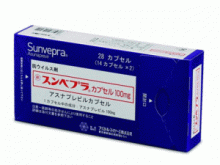阿舒瑞韦胶囊(Sunvepra Capsules 100mg)说明书
 产地国家:日本
处方药:是
所属类别: 100毫克/胶囊 28粒胶囊/盒
包装规格: 100毫克/胶囊 28粒胶囊/盒
计价单位:盒
生产厂家英文名:Bristol-Myers Co.,Ltd.
原产地英文商品名:Sunvepra Capsules (スンベプラカプセル)100mg/Cap 28Cap/box
原产地英文药品名:Asunaprevir
中文参考商品译名:Sunvepra胶囊(スンベプラカプセル)100毫克/胶囊 28粒胶囊/瓶盒
中文参考药品译名:阿舒瑞韦
产地国家:日本
处方药:是
所属类别: 100毫克/胶囊 28粒胶囊/盒
包装规格: 100毫克/胶囊 28粒胶囊/盒
计价单位:盒
生产厂家英文名:Bristol-Myers Co.,Ltd.
原产地英文商品名:Sunvepra Capsules (スンベプラカプセル)100mg/Cap 28Cap/box
原产地英文药品名:Asunaprevir
中文参考商品译名:Sunvepra胶囊(スンベプラカプセル)100毫克/胶囊 28粒胶囊/瓶盒
中文参考药品译名:阿舒瑞韦
简介
部分中文阿舒瑞韦处方资料(仅供参考) 英文名:Asunaprevir 商标名:Sunvepra Capsules 中文名:阿舒瑞韦胶囊 日文名:スンベプラカプセル100mg 生产商:百时美施贵宝药品 药物分类名称:抗病毒剂/HCV NS3/4A蛋白酶抑制剂 批准日期:2014年9月 欧文商標名:Sunvepra Capsules 一般名:アスナプレビル(Asunaprevir) 化学名 1,1-Dimethylethyl{(2S)-1-[(2S,4R)-4-({7-chloro-4-methoxyisoquinolin-1-yl}oxy)-2-({(1R,2S)-1-[(cyclopropanesulfonyl)carbamoyl]-2-ethenylcyclopropyl}carbamoyl)pyrrolidin-1-yl]-3,3-dimethyl-1-oxobutan-2-yl}carbamate 分子式:C35H46ClN5O9S 分子量:748.29 性状:Asnaprevir是一种白色至微黄色的白色粉末。 它极易溶于乙腈或二甲基亚砜,微溶于乙醇(99.5),几乎不溶于水。批准条件制定药品风险管理计划并适当实施。 药用药理学 1.作用机制Asnaprevir是一种HCV NS3/4A蛋白酶抑制剂。NS3/4A蛋白酶参与HCV多蛋白加工,用于病毒复制所必需的成熟病毒蛋白质生产。 2.抗病毒活性在生化检查,Asunaprevir显示了HCV基因型1的NS3 / 4A蛋白酶的强效抑制效果(1a和1b)(IC 50值:1A 0.7〜1.8nmol / L,1b的0.3nmol / L),对基因型2(2a和2b)的抑制作用较弱(IC 50值:2a 15 nmol / L,2 b 78 nmol / L)。在HCV复制子测定,Asunaprevir表明基因型1a的抑制作用,EC 50值分别复制子1B和2A 4nmol / L,1.2nmol / L,和230nmol / L。此外,在使用HCV复制子测定的组合研究中,asnaprevir与Daclatasville,干扰素α或利巴韦林组合显示出加和或协同作用。 3.药物耐受性在同时给予asnaprevir和daclatasville盐酸盐的基因型1b慢性丙型肝炎患者的临床试验中,通常在Daclattusville观察到asnaprevir的抗药性替代(替代NS3-D168) (更换NS5A-Y93和/或L31)。作为在asnaprevir存在下培养HCV复制子细胞的结果,发生了对asnaprevir的抗性。通过分析耐受基因型1b复制子的NS3蛋白酶结构域的基因,在活性位点的氨基酸残基中发现了突变,并且NS3蛋白酶的D168被取代为A,G,H,V或Y具有抗性。 确认这是一个原因。 具有这些取代的基因型1b的重组复制子的EC 50值是野生型的16至280倍。 4.交叉耐受具有抗性替代阿斯普雷韦的HCV复制子对具有不同作用机制的直接作用抗病毒剂如NS5A抑制剂足够敏感。 在通过给予telaprevir对HCV RNA没有阴性的慢性丙型肝炎患者中检测到的V36和T54的NS3中的氨基酸取代对asnaprevir的抗HCV活性仅有轻微影响,但是R155K,V36M + R155K和 在A156T / V中,asnaprevir的抗HCV活性降低至1/55至1/6。此外,在NS3的F43,Q80,R155,A156和D168中发现Simépville的主要耐受性替代,并且这些取代的asnaprevir的EC50值为simprevir的EC50值的约1/26至1/2。 适应症 改善慢性丙型肝炎或C型肝硬化血清群1(基因型1)中的病毒血症。 用法与用量 成人口服给药为100mg,每日两次,作为asenaprevir。该药与Daclatasville盐酸盐联合使用,给药期为24周。 包装胶囊100毫克:28粒(14粒×2)PTP 制造供应商:Bristol-Myers Squibb Co.Ltd。英文版说明书
Sunvepra (100mg asunaprevir) - A New Hepatitis C Drug for difficult-to-treat patientsThe last two years or so have been very successful for Hepatitis C treatments. The revolutionary new line of drugs that was registered for chronic Hepatitis C since 2013 feature over 90% cure rates and a pill-per-day regimens. Asunaprevir is the latest drug that could provide an edge especially in patients who are difficult to treat. With a completely new mechanism of action, asunaprevir (the drug is already registered in Japan under the trademark name Sunvepra) might be very useful for the following patients:•Asunaprevir could benefit patients who didn't respond to prior therapy with Sovaldi, Harvoni, Daklinza, Zepatier and so on•Asunaprevir could also benefit who were medically ineligible or intolerant to previous treatmentAsunaprevir, produced by Bristol-Meyers Squibb, has recently undergone clinical studies and is currently used (limited countries) under its trademark name Sunvepra with Daklinza (daclatasvir). Different regimens with interferon and ribavirin are being tested, as well as interferon-free and ribavirin-free regimen. In a mid-stage study, a 24-week regimen with asunaprevir and daclatasvir was used for the treatment of difficult-to-treat patients and achieved a promising 77% cure rate.How does Asunaprevir treat Hepatitis C?We already have several drug molecules for the treatment of Hepatitis C that as asunaprevir are very effective at fighting Genotype 1 cases. These include sofosbuvir, ledipasvir, daclatasvir, ribavirin and so on. One important difference between asunaprevir and these drugs is the novel mechanism of action asunaprevir brings to the table.For example, the most well-known Hepatitis C drug sofosbuvir works by inhibiting NS5B protein in Hepatitis C virus. Sofosbuvir is not used for treatment by its own; modern treatments fight Hepatitis C virus with 2 or more drug molecules. Harvoni, for instance, includes ledipasvir, an NS5A protein inhibitor, to more effectively fight HCV, and even the most basic Sovaldi (400mg sofosbuvir) regimen includes ribavirin or/and interferon.Safe to say, it is important to have as many as possible drugs working in different ways to most effectively treat Hepatitis C, and asunaprevir is another useful way how to target HCV. What is important to understand is that viruses are a living matter (albeit scientist disagree if viruses are actually alive or not; they do agree on that they are able to change and adapt to the environment). If you have ever wondered why we have 6 genotypes of Hepatitis C virus, here is your answer - it is this adaptational ability that enables HCV to change and fight against the drugs that are used to fight it.The solution: Hit HCV with everything we got at the same time. Hepatitis C treatment consists of two or more drugs to attack two or more targets in the virus. Asunaprevir offers us a new way to target the virus that proved to be very resilient to existing drugs.Asunaprevir Mechanism of ActionAsunaprevir (formerly known as BMS-650032) works unlike any other Hepatitis C on the market. The mechanism of action of asunaprevir is to target a specific HCV enzyme called serine protease NS3. This is an enzyme that virus needs for normal functionality and replication, and by blocking it, asunaprevir inhibits HCV ability to grow while immune system swoops in with antibodies to fight off the remaining virus.Asunaprevir's molecular structureSunvepra (100mg asunaprevir) is often partnered up with Daklinza (daclatasvir) for treatment. In such a way, daclatasvir can target NS5A protein while at the same time asunaprevir targets NS3. The virus can try to fight each of the drugs by changing its morphology, pumping out the drug, and so on, but if for example it can resist the attack of daclatasvir on NS5A protein, asunaprevir can still finish it off by attacking NS3 protein and impede HCV's ability to replicate.Asunaprevir in JapanSunvepra which consists of 100mg of asunaprevir is currently not registered as widely as other Hepatitis C drugs. The treatment is used primarily in Japan and Russia.In an official statement by Bristol-Meyers Squibb about asunaprevir, the chief scientist working on the project, Kazuaki Chayama of Hiroshima University in Japan, explain why asunaprevir was specifically registered in Japan.“Japan has a unique hepatitis C patient population, many of whom are older and have been unable to take, or respond to, traditional therapies, so we have a real sense of urgency to treat these patients now."Nonetheless, some speculation about BMS's move to limit the countries in which they registered Sunvepra point out that it may have something to do with limited competition in Japan and Russia, and the problem of lower effectiveness of asunaprevir regimen compared to other Hepatitis C treatments.When HCV becomes more and more resistant.In the case of viral infections such as Hepatitis C, an arsenal of many different drugs can prove very useful in the long term. Viruses such as HCV have outstanding survival mechanisms which can even render a drug that was once had 100% cure rate ineffective. By broadening the number of molecules we have to fight HCV, we are reducing the risk of HCV resistance to drugs. For example, if HCV learns how to render sofosbuvir inactive, we have daclatasvir, ledipasvir, ribavirin and now asunaprevir to continue the fight.Hepatitis C new drug daclatasvir+asunaprevir oral solution approved by JapanOn July 7, 2014, the Japanese Ministry of Health, Labor and Welfare approved the company's daclatasvir (Daklinza) + asunaprevir (Sunvepra) combination for the treatment of hepatitis C virus (HCV) genotype 1 infection, including treatment Those who have modern compensatory cirrhosis.Daclatasvir is a potent, all-gene NS5A replication complex inhibitor; and asunaprevir is an NS3/4A protease inhibitor. In Japan, the combination of these two drugs was the first non-interferon, ribavirin-free oral regimen that was formally approved for the treatment of HCV infection. This therapy combines the NS5A inhibitor daclatasvir and the NS3/4A protease inhibitor asunaprevir. This therapy is primarily designed to treat patients with genotype 1 hepatitis C. This is also the first full oral hepatitis C therapy in the world to officially enter the market.In Japan, the daclatasvir+asunaprevir combination regimen is for patients with chronic HCV genotype 1 infection with or without compensatory cirrhosis. These patients cannot tolerate or apply interferon-based treatment regimens or interferon-containing treatments. The protocol has no response; the combination is intended to improve viremia in this population.Daclatasvir is a potent, all-gene NS5A replication complex inhibitor; while asunaprevir is a NS3/4A protease inhibitor. In Japan, the combination of these two drugs was the first non-interferon-free, ribavirin-free oral regimen that was formally approved for the treatment of HCV infection.At the press conference, Bristol-Myers Squibb said that about 70% of the Japanese hepatitis C carriers were infected with the HCV gene type 1b. Dr. Kazuaki-Chayama of Hiroshima University in Japan said that there is a unique population of HCV patients in Japan, many of whom are older and cannot tolerate or respond to traditional treatments. Therefore, it is urgent to seek an effective treatment plan for this group of people.Dr. Chayama believes that the daclatasvir+asunaprevir combination regimen has been officially approved by the Japanese authorities, and for many of these HCV-infected people in Japan, for the first time, a new medication option has been obtained.In Japan, the daclatasvir+asunaprevir combination regimen is for patients with chronic HCV genotype 1 infection with or without compensatory cirrhosis. These patients cannot tolerate or apply interferon-based treatments or interferon-containing treatments. The protocol has no response; the combination is intended to improve viremia in this population.The research team led by Dr. Chayama conducted a phase III clinical trial. The results showed that Japanese HCV genotype 1 infected patients received the daclatasvir+asunaprevir regimen, and 84.7% of patients achieved a sustained virological response (SVR24) 24 weeks after the end of treatment.Among patients with hepatitis C who were unable to tolerate or were not eligible for interferon regimen over the age of 65, 91.9% of patients achieved SVR24 after treatment with this regimen; the proportion of patients with modern compensatory cirrhosis at baseline reached an SVR24 ratio of 90.9%.Only 5% of the subjects discontinued treatment because of adverse reactions. Among them, the incidence of serious adverse events was low (5.9%), and almost no serious adverse reactions occurred in more than one patient. Overall, nasopharyngitis is the most common adverse reaction (30.2%).用药温馨提示:当您服用此药物时,需定期接受医疗专业人士的检查,以便随时针对其药效、副作用等情况进行监测。本网站所包含的信息旨在为患者提供帮助,不能代替医学建议和治疗。
药品价格查询,专业药品查询网站,药品说明书查询,药品比价 » 阿舒瑞韦胶囊(Sunvepra Capsules 100mg)说明书
药品价格查询,专业药品查询网站,药品说明书查询,药品比价 » 阿舒瑞韦胶囊(Sunvepra Capsules 100mg)说明书





